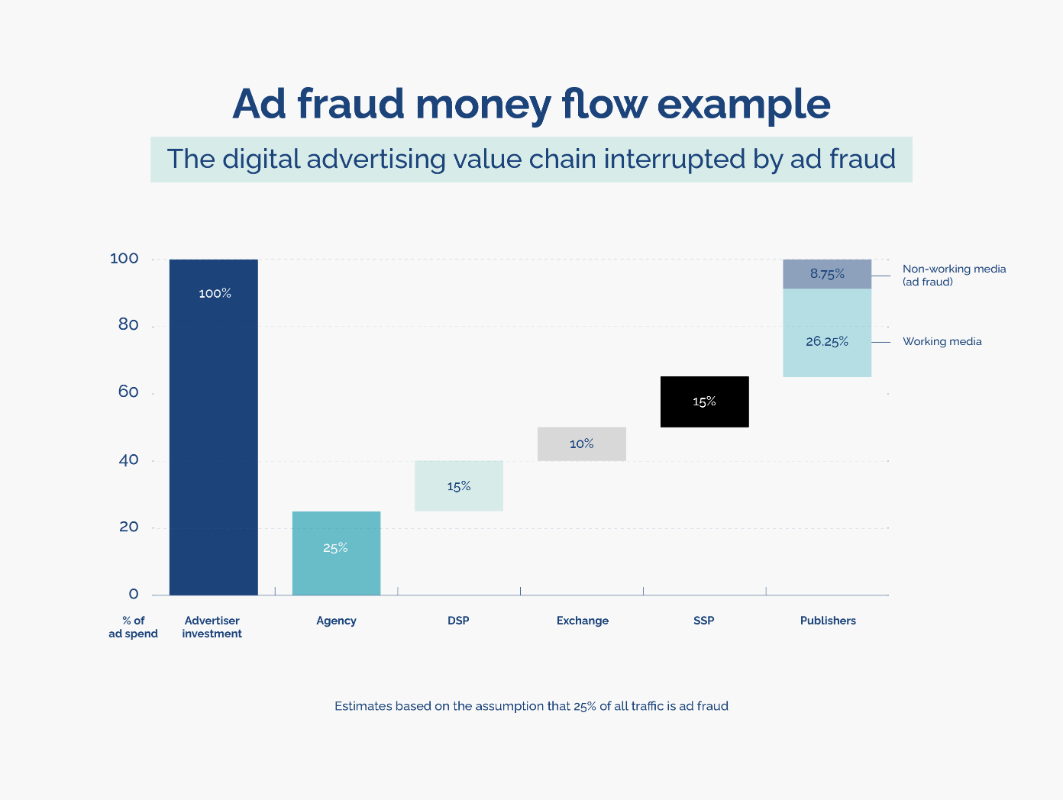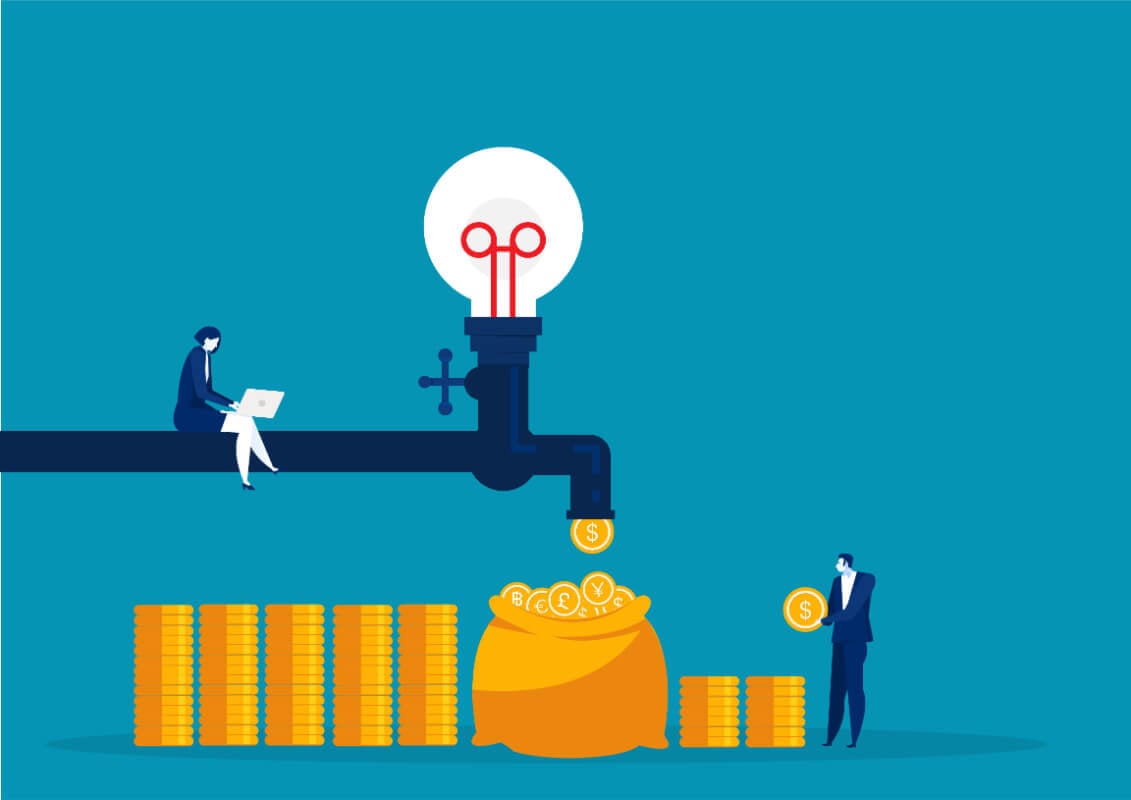We know who is behind ad fraud, but how do these bad actors drain advertiser budgets? How, exactly, does the money flow from your pockets into those of fraudsters?
Here, we take a look at what the ad fraud money flow looks like within the digital advertising ecosystem.
What does the digital advertising value chain look like?
Before we delve into the intricacies of the ad fraud money flow, we need to explore the digital advertising value chain and its actors. There are multiple entities that comprise the chain that is uninterrupted by ad fraud.
Advertiser
Advertisers buy ad space from publishers and ad networks in order to promote their products or services.
Agency
Agencies are hired to help brands deliver tailored messages to target audiences by buying the right ads.
Demand Side Platform (DSPs)
Demand-side platforms, or DSPs, are where brands, agencies, and marketers buy ads from across multiple different advertising exchanges. These platforms aggregate advertising inventory from several exchanges within one place, allowing for a greater level of efficiency.
Advertising exchange
Advertising exchanges are marketplaces that enable publishers to sell their ad inventory and connect to relevant ad networks. These exchanges operate autonomously and facilitate the entire programmatic ad buying process.
Supply Side Platform (SSP)
Supply-side platforms, or SSPs, enable publishers to sell their ad inventory across different ad exchanges. By making their inventory widely available via SSP platforms, publishers can ensure that they’re receiving the best possible offer, therefore maximizing revenue.
Publisher
Publishers are either websites or apps and ultimately provide traffic to digital ads by allowing advertisers to run ads in their apps or on websites. Publishers sell digital ad space to buyers and agencies.
How the ad fraud money flow works in practice
With so many players and opportunities for fraudsters to create fake websites and apps (ultimately leading to incalculable fake ad impressions), the digital advertising ecosystem can often be fragile and open to vulnerabilities. Fraudsters can easily enter, hide in, and exploit certain spheres of the ecosystem.
Fraudsters employ a variety of ad fraud techniques to falsify impressions, clicks, and leads on advertising campaigns, such as deploying bots, malware, and click farms.
How the money flows when it’s uninterrupted by ad fraud
1. Advertisers hire agencies to help them identify the best opportunities for their digital media budgets.
2. Agencies find the most appropriate ad exchanges, dividing up the budget between multiple exchanges based on how much inventory they can acquire and the price.
3. Publishers list ad space on their supply-side platform (SSP), which acts as the seller for publishers. The SSP will also list characteristics of the site, user, and ad space that inform DSPs to make their bids.
In this scenario, the money flows from the advertiser (the only player to introduce money within the chain) across to the publisher. This also means that the Return on Ad Spend (ROAS)—from the user’s ad click to the app install or conversion—flows from the publisher back to the advertiser.
How money flows when there is ad fraud present
However, when ad fraud enters this process, these expected returns don’t occur. In fact, given programmatic technologies’ automated nature of buying and selling ad impressions, clicks, and leads, ad fraud is more scalable than ever.
 Advertisers are the only player in the value chain that is directly affected by ad fraud while all others get their share regardless of whether there is fraud or not.
Advertisers are the only player in the value chain that is directly affected by ad fraud while all others get their share regardless of whether there is fraud or not.
The graphic above shows that advertisers could end up with around a quarter (26.25%) of their ad spend becoming working media. In other words, only approximately one in four Euros spent on ads could go to actually show them to legitimate users.
Since advertisers are paying for ads that aren’t seen or clicked by real users, it is in fact this group that becomes most disadvantaged by the presence of ad fraud within this chain—while, albeit inadvertently, publishers actually benefit from it.
What’s more is that since their budgets aren’t affected, many of the players within the digital advertising ecosystem don’t take proactive steps to counter occurrences of ad fraud since the resulting financial damage is experienced solely by advertisers.
This means that the ad fraud money flow continues on a loop, with advertisers being the only actor with a genuine need and interest in fixing the problem.
In the next section, we will explain how this can be achieved.
Here’s how advertisers can stop the ad fraud money flow and protect their returns
Ad fraud is a huge and pervasive issue that plagues the digital advertising industry at large. Advertisers, however, bear the brunt of the financial losses that occur as a result of the ad fraud money flow. But, that doesn’t mean that they should stop or limit their advertising efforts.
Instead, and as a priority, advertisers need to identify ways of preventing ad fraud from entering their ad campaigns in order to make the most of their advertising spend.
Ad fraud prevention solutions like Opticks help you detect any leaky advertising operations and fraudulent partners and also help you invest your ad spend wisely in legitimate advertising. In combination with a full ad fraud prevention function, advertisers can improve their ROAS by an average of 11%.
To find out more about how the expert team at Opticks can help protect and optimize your ad returns, contact us now.
